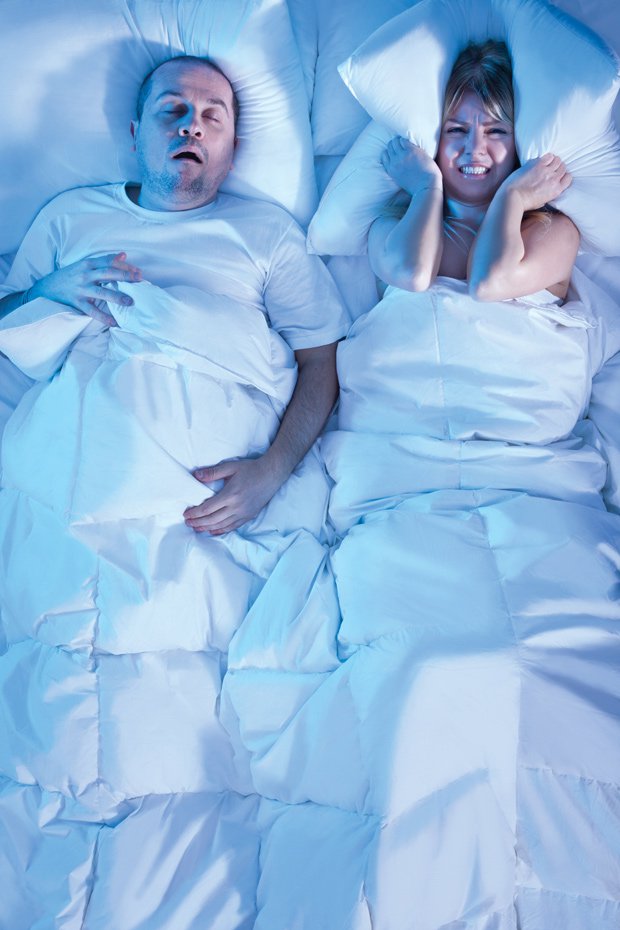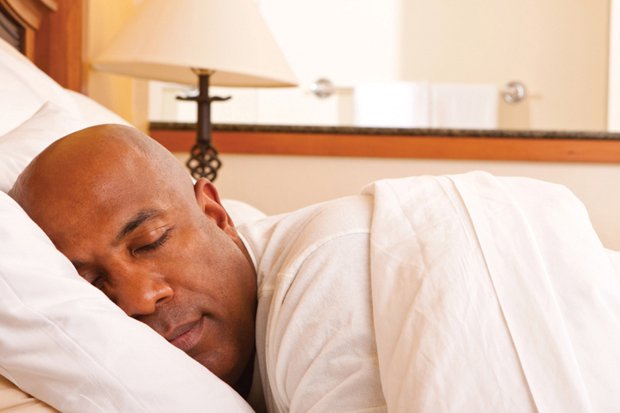Virginia sleep experts give us the prescription for perfect slumber.


If you feel yourself slipping into a drowsy, head-bobbing doze as you read this, you may be one of a growing group of Americans—70 million, in fact, as estimated by Centers for Disease Control—who regularly experience some form of sleep difficulty.
The National Sleep Foundation recommends that adults sleep seven to nine hours a night, but 63 percent of adults report they don’t. What’s keeping them up? High-pressure jobs, financial stress, caring for children with increasingly demanding schedules, managing a loved one’s illness, frequent travel and time-zone changes, and obesity are all potential obstacles to sound sleep. Throw in the technology that has infiltrated our lives around the clock—tablets, laptops, cell phones—and the deck is stacked against optimum rest. That late-night game of WarCraft’s Reign of Chaos and TV news broadcasts give us about as good a chance of sleeping soundly as a screech owl on a mouse hunt.
“Technology is a major contributor,” says Dr. Deborah Gofreed, medical director of Arlington Sleep Medicine, which specializes in the medical evaluation and treatment of sleep disorders. “These products create light when it’s supposed to be dark and when it’s natural to feel sleepy. You can’t go to sleep easily if, three minutes before, you’re watching something scary.” But even if you’re just tuning in to “Late Night with Jimmy Fallon,” artificial light, like that emitted by TVs and computer screens, not only suppresses the naturally occurring, sleep-promoting hormone melatonin, it also enhances alertness and shifts the circadian rhythm—the 24-hour cycle of our biological clock that changes in response to light and darkness—to a later hour, making it more difficult to fall asleep.
Sleep disorders vary from severe obstructive sleep apnea—an involuntary closing of the airway due to the relaxation of muscles in the throat—to chronic insomnia, night terrors, restless legs syndrome (an unpleasant sensation upon going to bed that is sometimes alleviated by leg movements), and the rare but disturbing exploding head syndrome in which a patient can be jolted awake by the sensation that something akin to a bomb has detonated in his skull—among many others.
The consequences can be significant—and costly. Health risks for sleep apnea sufferers include heart attacks, high blood pressure, stroke and diabetes, while patients suffering from any of these ailments can experience compromised cognitive function, depression, irritability, impaired memory and daytime drowsiness. In addition, the Institute of Medicine, under the auspices of the National Academy of Sciences, estimated that 20 percent of car accident injuries involve sleepiness at the wheel from data it gathered in a 2006 research study.
Sleeping-while-driving is a threat Dr. Kathe Henke, laboratory director of the Sleep Disorders Center of Virginia in Richmond, knows well. “We’ve had patients asleep at traffic lights who haven’t woken up until a police officer knocks on the window,” she says, “and others who have fallen asleep while talking to their bosses.”
A 53-year-old Alexandria resident who works night shifts on security detail—and who asked to remain anonymous so as not to alarm his employer—is one of those patients. “I got to the point that I was falling asleep in meetings and at traffic lights,” says the security officer who is now a client of Arlington Sleep Medicine. “It became somewhat of a hazard.” He made an appointment for what would be the first of four sleep studies known as polysomnographies, and, just 45 minutes after he nodded off, the monitoring technician diagnosed him with severe sleep apnea, a condition in which a patient can unwittingly awaken hundreds of times per minute because he is not able to breathe.
Ever since, he has been using Continuous Positive Airway Pressure (CPAP), the gold-standard device that continuously pumps humidified air into the airway of the sleeping patient via a mask and hose strapped to the head, thus regulating the flow of oxygen to the brain. The once-bulky and uncomfortable device has become available in increasingly sleek and comfortable designs from manufacturers such as ResMed and Philips Respironics whose new Wisp mask does not obstruct the user’s field of vision.
Sleep apnea is believed to affect between two and four percent of the population, more men than women, though the rate among post-menopausal women is higher. Although 12 to 18 million Americans—80-90 percent of sufferers—remain untreated, sales of CPAP machines like ResMed are an indication of how many sufferers are being helped. Constance Bienfait, director of investor relations, says ResMed recorded $1.4 billion in sales for the fiscal year ending in June 2012 and 71 straight quarters of revenue growth, making it one of the fastest growing businesses in the medical devices sector. (CPAPs are covered 100 percent by most health insurance.) And the technology is maturing. In addition to new lines like the S9 series by ResMed, Philips Respironics has just introduced the SleepMapper, a free, mobile, Web-based application compatible with a CPAP that enables a patient to analyze his sleep performance via a laptop, cell phone, or tablet without having to phone a physician.
Other solutions available on the market include mouth guards known as mandibular advancement devices and Provent, a disposable adhesive bandage fitted with a valve for breathing that the patient affixes to each nostril upon going to bed. Henke says both devices are options for patients with milder forms of sleep apnea, but their success rates are not as high as that of a CPAP machine because they do not reduce the number of apneas (temporary suspensions of breathing) as dramatically.
But what about other nocturnal challenges, such as insomnia and restless legs? Some are treated effectively with prescription drugs. Non-benzodiazopine hypnotics like Ambien and Lunesta are used to treat short-term insomnia, while drugs often used for treating patients with Parkinson’s disease like Mirapex, Neurontin and Requip are prescribed for restless legs syndrome because they help regulate muscle movements. Parasomnias—nightmares, night terrors, sleepwalking and REM sleep behavior disorder in which one acts out a violent dream like choking a sleep partner while still asleep—are often treated with benzodiazopenes (a subgroup of hypnotics) like Restoril, Klonopin and Valium.
A methodology that has been around since the 1980s—Cognitive Behavioral Therapy for Insomnia (CBTI)—is gaining new favor in treating chronic insomnia, which, according to the American Academy of Sleep Medicine afflicts between 33 and 50 percent of the population (10 to 15 percent of that group also report distress or impairment as a result of lack of sleep). Dr. Bruce Rybarczyk, director of the clinical psychology program at Virginia Commonwealth University, is a pioneer of CBTI, an alternative to some pharmaceutical therapies that aims to help a patient reform the bad habits that may impede sleep. “Insomnia is not a disease; it’s a symptom of a problem,” says Rybarczyk. “In this therapy, we basically give patients the owner’s manual to their sleep system, and we show them how to keep it properly tuned up.” Rybarczyk, who has an 80 percent success rate with this treatment, believes that as many as 98 percent of chronic insomnia sufferers could benefit from it, though he says only those who are very persistent with their physicians find out about the treatment.
“There are so many commercial products out there that really clutter things up,” he says. “The pharmaceutical industry is not really the right answer, although I have no objection to using sleep aids for the treatment of episodic insomnia—when you travel, for example.” Synthetic melatonin, for instance, can be used as a sleep aid taken several hours before bed and is most effective for easing back into a new time zone after a long trip.
Dr. Rybarczyk offers a six-week course of treatment, which includes in-office counseling and homework, and guides patients through everything from stimulus control, such as removing computers from their bedrooms and participating in quiet activities for an hour before bed, to sleep restriction methods such as deliberately depriving them of sleep with late bedtimes and early wake-ups for enough consecutive nights that their circadian rhythm resets.
One of Dr. Rybarczyk’s patients, 38-year-old Mehrima Matrood, worked with Rybarczyk from April to September of last year in hopes of finding an antidote to the insomnia that had plagued her for 20 years. “I was tired and cranky, and people noticed that I wasn’t my happy self,” says Matrood, who had been prescribed numerous sleeping pills over the years, including Ambien and Tegretol. But, says Matrood: “None of them worked.”
After six or seven visits to Rybarczyk and faithful compliance to instructions that had her grocery shopping, doing laundry and calling on friends and family to keep her awake until 1:30 a.m. for the first two weeks, she ultimately succeeded in establishing a new sleep schedule from 11:30 p.m. to 5:00 a.m., a major improvement for someone who previously went days without sleep and often found herself sneaking off to her car for a catnap during her lunch hour.
“It’s amazing,” says Matrood. “No medicine; just talking and time adjustments. I’ve got my personality back.”
Sometimes, it seems, you have to wake up before you can go to sleep. Soundly.
Sleep Tight
Sleep experts recommend the following tips for those suffering from insomnia:
Establish regular wake-up and turn-in times, even on the weekends.
Do not watch TV, read, or use your computer in bed.
Exercise regularly, but not within three hours of your bedtime.
Avoid caffeine after midday.
Stop smoking.
Take a warm bath or shower one hour before bedtime.
Before you turn in, release stressful thoughts by writing them down.
Reduce or eliminate evening alcohol consumption.
Make your bedroom a comfortable and peaceful place.








